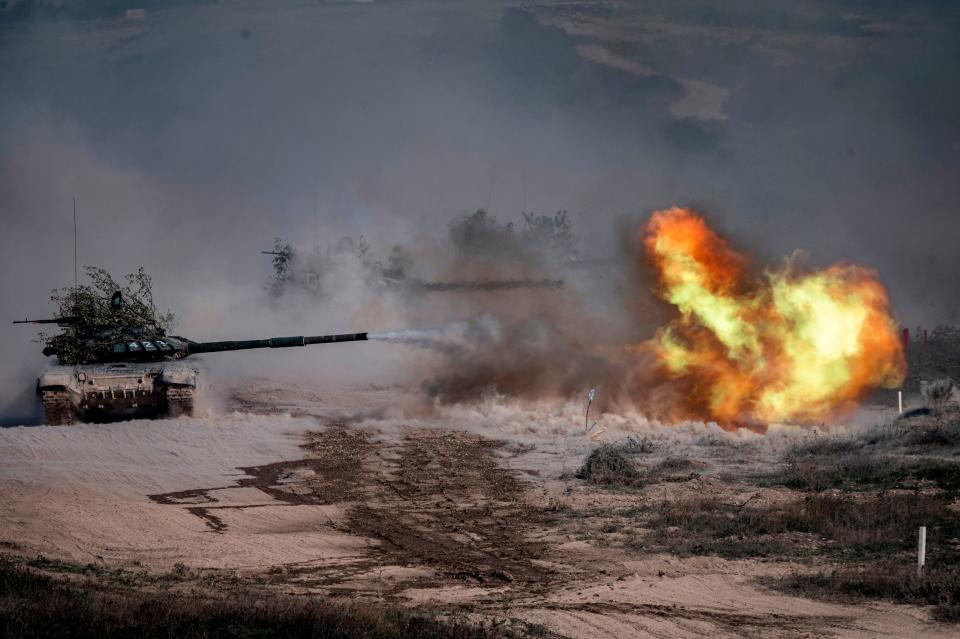Video of a cheap drone destroying an exposed T-72 hints Russian crews are still working out how to hide their tanks from a growing threat, former US general says
A video surfaced online showing a seemingly exposed Russian T-72 tank struck by an FPV drone.
Top US military officers took note of the lack of basic concealment or camouflage.
One former US Army general told Insider it may speak to larger issues within the Russian military.
A video of what looks like a cheap drone destroying a Russian T-72 tank seems to speak to Ukraine's skillful use of unmanned aerial vehicles (UAVs) in combat and shed light on potential problems within the Russian military with regard to basic training and communication of key lessons in an evolving fight, according to a former top US Army general.
The video was shared online by Ukraine war monitors on Monday, although it's unclear exactly when and where it was recorded, and appears to show a T-72 tank relatively exposed amid some shrubbery near dirt roads without obvious camouflage, making it a prime target for a first-person view (FPV) drone rigged with an explosive.
The UAV seems to identify the tank before diving and slamming into it, causing a massive explosion. In the aftermath, the T-72 is completely ruined, with flaming pieces of the wreckage spread around the area. The tank's turret is one of the pieces that goes flying, a long-standing issue with the old Soviet-era tanks.
—Saint Javelin (@saintjavelin) September 18, 2023
It's far from a novel occurrence. Throughout the war, a variety of videos have been shared on Telegram and by open-source intelligence accounts documenting FPV kamikaze drones destroying Russian tanks. It's an asymmetrical loss for Moscow, as expensive, valuable assets and crews are struck and eliminated by comparatively cheap UAVs, which Ukraine has been employing in large numbers and with great skill.
But this specific video sparked reactions from former top US military officers, with James Stavridis, a retired US Navy admiral and a former top NATO commander, posting on X, formerly known as Twitter, that "it appears this Russian tank is going to need more than a little time in the shop" and Mark Hertling, a retired US Army general and a former head of US Army Europe saying "this one won't be back in the motor pool by Friday."
Ben Hodges, a retired lieutenant general and former commander of US Army Europe, posted more pointed criticism. "I continue to be surprised by the poor camouflage and ineffective efforts at concealment by Russian forces," he wrote. "Basic field craft. But it requires experienced demanding Sergeants."
Hodges told Insider the Russian tank looked to be "easily identifiable from the air," and considering that both sides of the war have been building seemingly endless stockpiles of drones to launch at one another, the Russian crew needed to be conscious of being spotted.
He added that efforts to conceal the tank and make it harder to target could have included net and foliage that breaks up the hard outlines of the vehicle. Or Russian forces could've taken a more modern approach — flying their own drones above their position to scout, protect, and counter-attack.
The lack of such efforts and the certainly fatal results may reflect deeper, underlying issues for the Russian military. A single incident alone might not, but failures in basic tactics appear frequently in videos of Russian troops in action.
Eighteen months into this war, training and the communication of lessons from the battlefield across the force appear to be a significant problems for Russian forces. And one of the most glaring aspects of these issues seems to be a lack of experienced troops training fresher, younger recruits on "things like tactical concealment," Hodges said.

Drone warfare has taken the center stage in Ukraine, painting a clear picture of what future conflicts involving UAVs could look like. Russian and Ukrainian FPV drones are pummeling tanks while other drones drop bombs on soldiers.
Meanwhile, Ukraine has demonstrated a special talent for driving unmanned surface vehicles (USVs) like exploding drone boats into Russian ships and bridges, making the Black Sea a nightmare to navigate. Russian, on the other hand, has used loitering munitions like the Shahed-136 to ruthlessly attack civilian targets.
Both the Ukrainians and Russians are having to adapt to the growing threat of drones on the battlefield, and it's something that both sides struggle with. Some crews react better than others, but one thing Ukraine has that Russia does not is a strong noncommissioned officer (NCO) corps able to instill critical lessons across the armed forces. And casualties are only making the problem worse for Russia.
"This has never been a strong suit in the Russian Army, but they've lost so many of their experienced soldiers by now that the problem is even worse," he added.
Ukraine spent years building a Western-style military structure, giving them a stronger support network across ranks. But Russia lacks a similar corps of noncommissioned officers, and many of their more experienced units have been decimated by high casualties and filled with lackluster replacements.
That's left the Russian military weak in leadership and experience at the tactical level, resulting in a regular stream of videos of Russian armor driving into a well-executed ambush, attack helicopters flying into air defenses, and exposed infantry clustering within range of rocket artillery.
Read the original article on Business Insider

